Hyundai Matrix 2006 User Guide
Manufacturer: HYUNDAI, Model Year: 2006, Model line: Matrix, Model: Hyundai Matrix 2006Pages: 490, PDF Size: 11.58 MB
Page 11 of 490
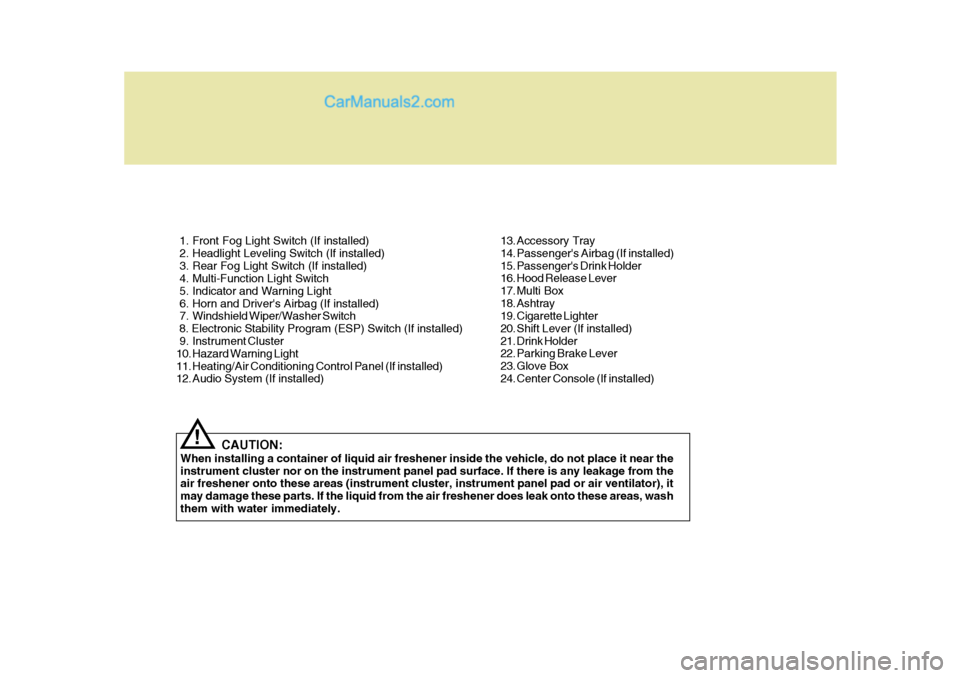
1. Front Fog Light Switch (If installed)
2. Headlight Leveling Switch (If installed)
3. Rear Fog Light Switch (If installed)
4. Multi-Function Light Switch
5. Indicator and Warning Light
6. Horn and Driver's Airbag (If installed)
7. Windshield Wiper/Washer Switch 8. Electronic Stability Program (ESP) Switch (If installed)
9. Instrument Cluster
10. Hazard Warning Light
11. Heating/Air Conditioning Control Panel (If installed)
12. Audio System (If installed)CAUTION:
When installing a container of liquid air freshener inside the vehicle, do not place it near the instrument cluster nor on the instrument panel pad surface. If there is any leakage from the air freshener onto these areas (instrument cluster, instrument panel pad or air ventilator), it may damage these parts. If the liquid from the air freshener does leak onto these areas, washthem with water immediately.
! 13. Accessory Tray
14. Passenger's Airbag (If installed)
15. Passenger's Drink Holder
16. Hood Release Lever
17. Multi Box
18. Ashtray
19. Cigarette Lighter
20. Shift Lever (If installed)
21. Drink Holder
22. Parking Brake Lever
23. Glove Box
24. Center Console (If installed)
Page 12 of 490

B250B02FC-GATINSTRUMENTS AND CONTROLS
(RIGHT-HAND DRIVE)
B250A02FC-D
Page 13 of 490
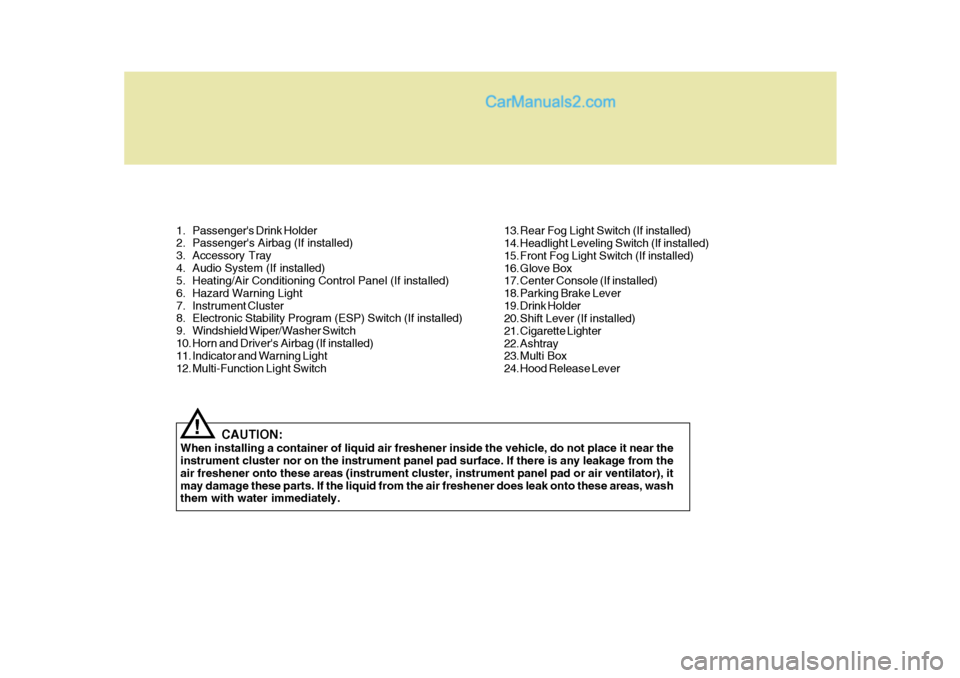
1. Passenger's Drink Holder
2. Passenger's Airbag (If installed)
3. Accessory Tray
4. Audio System (If installed)
5. Heating/Air Conditioning Control Panel (If installed)
6. Hazard Warning Light
7. Instrument Cluster
8. Electronic Stability Program (ESP) Switch (If installed)
9. Windshield Wiper/Washer Switch
10. Horn and Driver's Airbag (If installed)
11. Indicator and Warning Light
12. Multi-Function Light SwitchCAUTION:
When installing a container of liquid air freshener inside the vehicle, do not place it near the instrument cluster nor on the instrument panel pad surface. If there is any leakage from the air freshener onto these areas (instrument cluster, instrument panel pad or air ventilator), itmay damage these parts. If the liquid from the air freshener does leak onto these areas, wash them with water immediately.
! 13. Rear Fog Light Switch (If installed)
14. Headlight Leveling Switch (If installed)
15. Front Fog Light Switch (If installed)
16. Glove Box
17. Center Console (If installed)
18. Parking Brake Lever
19. Drink Holder
20. Shift Lever (If installed)
21. Cigarette Lighter
22. Ashtray
23. Multi Box
24. Hood Release Lever
Page 14 of 490
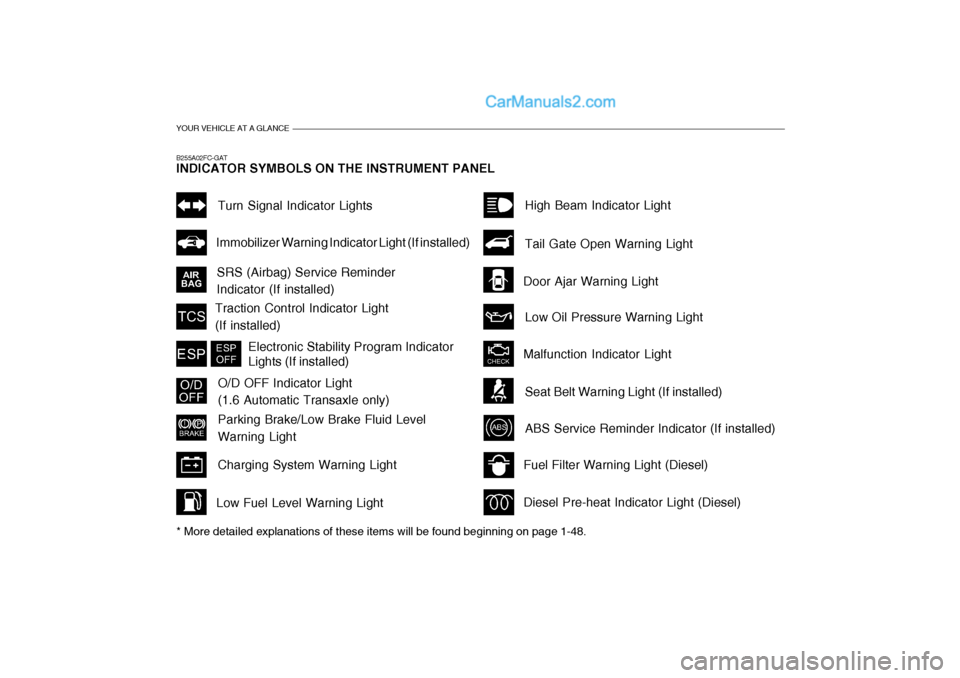
YOUR VEHICLE AT A GLANCE
B255A02FC-GAT INDICATOR SYMBOLS ON THE INSTRUMENT PANEL * More detailed explanations of these items will be found beginning on page 1-48.
SRS (Airbag) Service Reminder Indicator (If installed)Turn Signal Indicator Lights
Malfunction Indicator Light
Traction Control Indicator Light(If installed)
O/D OFF Indicator Light (1.6 Automatic Transaxle only)
Parking Brake/Low Brake Fluid Level Warning Light
Charging System Warning Light
Fuel Filter Warning Light (Diesel) Diesel Pre-heat Indicator Light (Diesel)
Immobilizer Warning Indicator Light (If installed)
ABS Service Reminder Indicator (If installed)
High Beam Indicator Light Low Oil Pressure Warning Light
Tail Gate Open Warning Light
Door Ajar Warning Light
Low Fuel Level Warning Light
Electronic Stability Program Indicator Lights (If installed)
Seat Belt Warning Light (If installed)
Page 15 of 490
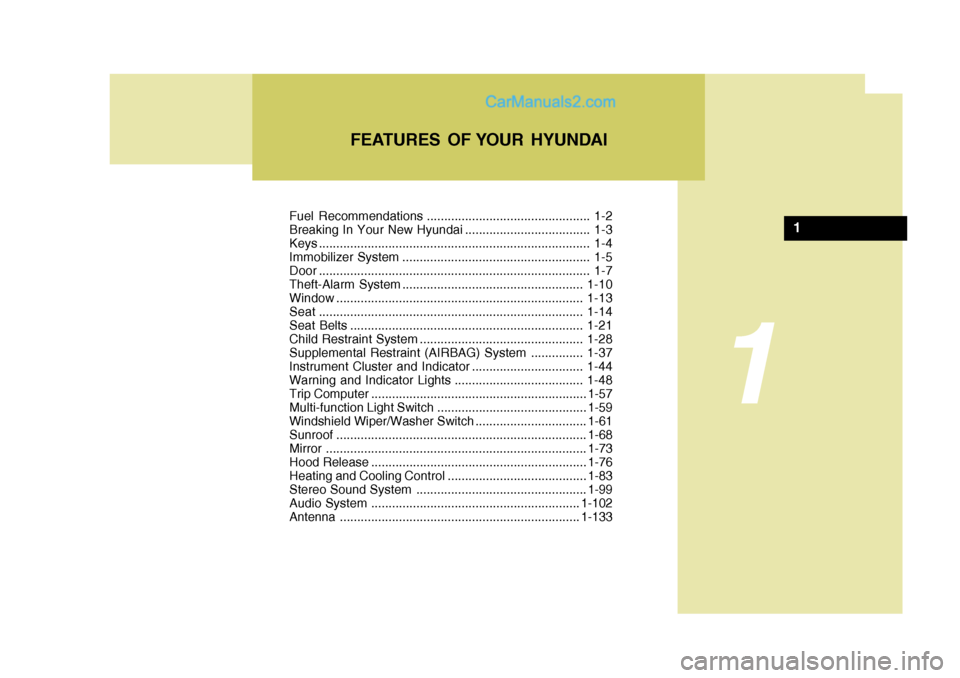
Fuel Recommendations ............................................... 1-2
Breaking In Your New Hyundai .................................... 1-3
Keys .............................................................................. 1-4
Immobilizer System ...................................................... 1-5
Door .............................................................................. 1-7
Theft-Alarm System ....................................................1-10
Window ....................................................................... 1-13
Seat ............................................................................ 1-14
Seat Belts ................................................................... 1-21
Child Restraint System............................................... 1-28
Supplemental Restraint (AIRBAG) System ............... 1-37
Instrument Cluster and Indicator ................................ 1-44
Warning and Indicator Lights ..................................... 1-48
Trip Computer .............................................................. 1-57
Multi-function Light Switch ........................................... 1-59
Windshield Wiper/Washer Switch ................................1-61
Sunroof ........................................................................ 1-68
Mirror ........................................................................... 1-73
Hood R elease .............................................................. 1-76
Heating and Cooling Control .......... ..............................1-83
Stereo Sound System ................................................. 1-99
Audio System ............................................................ 1-102
Antenna ..................................................................... 1-133
FEATURES OF YOUR HYUNDAI
1
1
Page 16 of 490
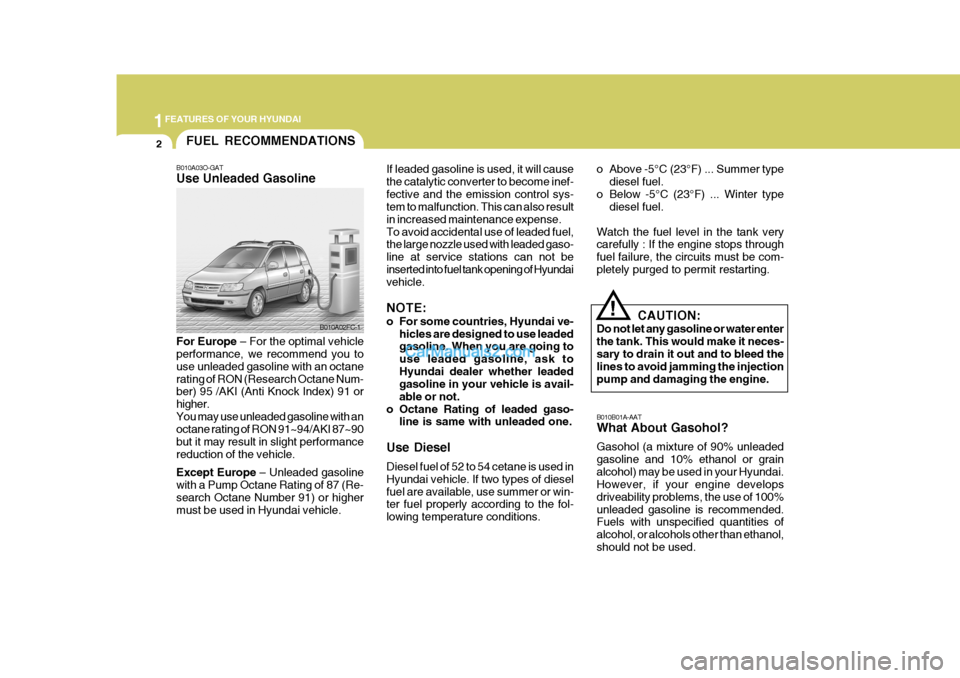
1FEATURES OF YOUR HYUNDAI
2
B010B01A-AAT What About Gasohol? Gasohol (a mixture of 90% unleaded gasoline and 10% ethanol or grainalcohol) may be used in your Hyundai. However, if your engine develops driveability problems, the use of 100%unleaded gasoline is recommended. Fuels with unspecified quantities of alcohol, or alcohols other than ethanol,should not be used.
B010A03O-GAT Use Unleaded Gasoline For Europe
– For the optimal vehicle
performance, we recommend you to use unleaded gasoline with an octanerating of RON (Research Octane Num- ber) 95 /AKI (Anti Knock Index) 91 or higher.You may use unleaded gasoline with an octane rating of RON 91~94/AKI 87~90 but it may result in slight performancereduction of the vehicle. Except Europe – Unleaded gasoline
with a Pump Octane Rating of 87 (Re- search Octane Number 91) or higher must be used in Hyundai vehicle. If leaded gasoline is used, it will causethe catalytic converter to become inef-fective and the emission control sys- tem to malfunction. This can also result in increased maintenance expense.To avoid accidental use of leaded fuel, the large nozzle used with leaded gaso- line at service stations can not beinserted into fuel tank opening of Hyundai vehicle. NOTE:
o For some countries, Hyundai ve-
hicles are designed to use leaded gasoline. When you are going to use leaded gasoline, ask toHyundai dealer whether leaded gasoline in your vehicle is avail- able or not.
o Octane Rating of leaded gaso- line is same with unleaded one.
Use Diesel Diesel fuel of 52 to 54 cetane is used in Hyundai vehicle. If two types of dieselfuel are available, use summer or win- ter fuel properly according to the fol- lowing temperature conditions. CAUTION:
Do not let any gasoline or water enterthe tank. This would make it neces-sary to drain it out and to bleed the lines to avoid jamming the injection pump and damaging the engine.
!
B010A02FC-1
FUEL RECOMMENDATIONS
o Above -5°C (23°F) ... Summer typediesel fuel.
o Below -5°C (23°F) ... Winter type diesel fuel.
Watch the fuel level in the tank very carefully : If the engine stops through fuel failure, the circuits must be com-pletely purged to permit restarting.
Page 17 of 490

1
FEATURES OF YOUR HYUNDAI
3
B010D01S-AAT Do not Use Methanol Fuels containing methanol (wood al- cohol) should not be used in yourHyundai. This type of fuel can reduce vehicle performance and damage com- ponents of the fuel system. B010E01A-AAT Gasolines for Cleaner Air To help contribute to cleaner air, Hyundai recommends that you usegasolines treated with detergent addi- tives, which help prevent deposit for- mation in the engine. These gasolineswill help the engine run cleaner and enhance performance of the Emission Control System.
!
CAUTION:
Your Hyundai's New Vehicle Lim- ited Warranty may not cover dam-age to the fuel system and perfor- mance problems that are caused by the use of methanol or fuels con-taining methanol. B020A01S-GAT During the First 2,000 Km (1,200 Miles) (Gasoline Engine) No formal "break-in" procedure is re- quired with your new Hyundai. How-ever, you can contribute to the eco- nomical operation and durability of your Hyundai by observing the followingrecommendations during the first 2,000 km (1,200 miles).
o Don't drive faster than 88 km/h (55
mph).
o While driving, keep your engine speed (rpm, or revolutions per minute) between 2,000 rpm and 4,000 rpm.
o Use moderate acceleration. Don't start, depress the accelerator pedalfully.
o For the first 300 km (200 miles), try to avoid hard braking.
o Don't lug the engine (in other words, don't drive so slowly in toohigh a gear that the engine "bucks": shift to a lower gear).
B010F01A-AAT Operation in Foreign Countries If you are going to drive your Hyundai in another country, be sure to:
o Observe all regulations regarding
registration and insurance.
o Determine that acceptable fuel is available. BREAKING IN YOUR NEW HYUNDAI
Page 18 of 490

1FEATURES OF YOUR HYUNDAI
4
B030A01A-AAT
B030A01B
o Use moderate acceleration. Don't
start, depress the accelerator pedal fully.
o For the first 300 km (200 miles), try
to avoid hard braking.
o Don't lug the engine (in other words, don't drive so slowly in too-high agear that the engine "bucks": shift toa lower gear).
o Whether going fast or slow, vary
your speed from time to time.
o Don't let the engine idle longer than 3 minutes at one time.
o Don't tow a trailer during the first 1,000 km (600 miles) of operation. For greater convenience, the same key operates all the locks in your Hyundai. However, because the doors can belocked without a key, carrying a spare key is recommended in case you acci- dentally lock one key inside the car.
o Whether going fast or slow, vary your
speed from time to time.
o Don't let the engine idle longer than 3 minutes at one time.
o Don't tow a trailer during the first 2,000 km (1,200 miles) of opera- tion. KEYS
B020B01FC-GAT During the First 1,000 Km (600 Miles) (Diesel Engine) No formal "break-in" procedure is re- quired with your new Hyundai. How- ever, you can contribute to the eco- nomical operation and durability of yourHyundai by observing the following recommendations during the first 1,000 km (600 miles).
o While driving, keep your engine speed (rpm, or revolutions per minute) within 3,000 rpm.
o While driving, keep under three quar-
ters of maximum speed.
Page 19 of 490

1
FEATURES OF YOUR HYUNDAI
5IMMOBILIZER SYSTEM
B030B01B B880A01A-GAT (If Installed) The immobilizer system is an anti-theft device, designed to deter automobiletheft.
B030B01A-AAT Record Your Key Number
A code number is stamped on the number plate that came with the keys to your Hyundai. This key numberplate should not be left with the keys but kept in a safe place, not in the vehicle. The key number should alsobe recorded in a place where it can be found in an emergency. If you need additional keys, or if you should lose your keys, your authorized Hyundai dealer can make new keys ifyou can supply the key number. B880B03A-GAT Keys All of the locks fitted to the vehicle are operated by the same key. However, since it is possible to lock the doorswithout the use of the key, care should be exercised to ensure that the key does not become locked inside thevehicle by mistake.
AX10020ANOTE: If you make your own duplicate key, you will not be able to cancel the system or start the engine.
B880C02A-GAT Key Numbers The vehicle key number is recorded upon a metal tag attached to the keys when the vehicle is first delivered to you. AX10030A
Page 20 of 490

1FEATURES OF YOUR HYUNDAI
6
B880D02A-GAT Limp home procedures
The key number should be recorded and kept in a safe place in case theneed to order further keys arises. New keys are available from any Hyundai dealer by quoting the relevant keynumber. In the interest of security, the metal tag attached to the keys which bears thekey number should be removed from the key ring after you receive your new vehicle. In addition, key numbers can-not be provided by Hyundai for secu- rity reasons. If you need additional keys or if youshould lose your keys, your authorized Hyundai dealer can make new keys. In case the immobilizer warning indica-tor blinks for five seconds when the ignition key is turned to "ON" position,this indicates that the immobilizer sys- tem is out of order. And you cannot start the engine without the limp homeprocedures with ignition key. The following procedure is how to start the engine with the function of the limphome. (0, 1, 2, 3 as a sample pass- word).B880D02FCNOTE: You can get the limp home pass- word when the vehicle is first deliv- ered to you. If you do not have thepassword, consult your authorized Hyundai dealer.
1. To set the password you may turn
the ignition key "ON" and then turn it "OFF" according to the digit num-bers, then the immobilizer indicator will blink along with the operation of the ignition key. For example, turnthe ignition key once for digit num- ber "1", and twice for "2", and so on. However, for the digit number "0",you must turn the ignition key for 10 times.
2. Wait for 3~10 seconds.
3. You may set the remaining number of digits by following the same pro-cedures 1 and 2.
4. If all of four digits have been tried successfully, turn the ignition key"ON" and check that the immobi-lizer indicator illuminates. From this time, you have to start your engine within 30 seconds. If you start yourengine after 30 seconds, your en- gine will not start.